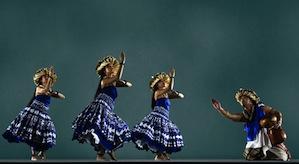- San Francisco Ethnic Dance Festival
- In A 'Historically Informed Manner'
- John Adams' Inuksuit: The Percussionist's Art
- Best Bets For Kids, This Weekend
San Francisco Ethnic Dance Festival
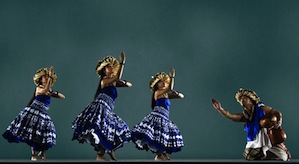
When you see Na Kawika Alfiche on stage, and you understand what he and his group, Hālau o Keikiali`i, are really doing, you realize how misleading is the image of young women swaying languorously at Waikiki; that stereotype of island eroticism set to the voice of Don Ho singing, Tiny Bubbles.
What Na Kawika Alfiche is actually doing is a very evocative and layered form of prayer, and in that sense the Hula dance is deeply intimate. Incidentally, the prayer is directed to various deities, which Kawika feels more comfortable in describing it (after a pause in our conversation to mark the awkwardness), in terms of “spirituality” rather than paganism — ever a scary word on the mainland, although less so in the Bay Area.
Hālau o Keikiali`i has been a cultural group, and a dance group, based in South San Francisco since 1994. It will perform in the Novellus Theater at the Yerba Buena Center for the Arts on June 16 at 3 p.m and 8 p.m. and June 17 at 3 p.m. Tickets are $18-$58.
The program is focused on ancient music, which as Mr. Kawika explains, means “before contact.” Another kind of BC. Or you could also say, Before Cook, the British captain who arrived in January 1778 and ended the culture’s splendid isolation (James Cook would be killed a year later after a minor skirmish between sailors and Hawaiians). Up until the outside world arrived, bearing European instruments and disease, Hawaiian music was expressed through drumming and chanting.
The songs you will hear — and you should hear them — honor chiefs as well as kings and queens. These are “genealogy” songs. In fact, each song begins with a short chant that describes a particular genealogy.
The final song in the program is about the 7th and last king of Hawaii, Kalakaua, who died in 1891, on a trip to San Francisco. Afterward, his sister and successor, Queen Lili`uokalani, took a train ride along the lee side of the main island, stopping here and there to meet the people, and in the song we learn of her adventures.
“What you’re watching is spirituality in action,” says Mr. Kawika. “And the energy that you see in us is a way the dancers can lift themselves out of their body. So the song isn’t just a song. It’s a story and a prayer. And every movement in the dance is part of that prayer.”
In A 'Historically Informed Manner'
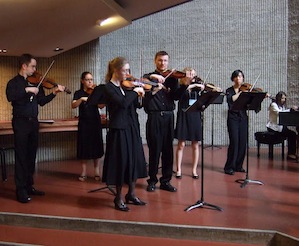
The fact is that Early Music is a wholly different temperament, literally and figuratively, from more modern classical music.
Christine Wilkinson will explain.
Wilkinson is a 28-year-old violinist, and an Early Music scholar who started playing the violin at 4, fell in love with Early Music at 10, and studied with the founder and director of Seattle Baroque, Ingrid Matthews, at 13. She has played in various collegia musica. For a while she even took up the treble viola de gamba, that instrument often played on the lap and first developed during the Renaissance and Baroque periods.
Skipping ahead, Wilkinson just received her Masters from Case Western Reserve. She has become a musician’s musician when it comes to Early Music, which refers to a period between 800 and the end of the Baroque period in 1760, although there has been early music movement creep and so now sometimes pieces of music from Haydn, Mozart, and Brahms are included. Wilkinson says:
In the U.S., Early Music was looked down upon by a lot of musicians. If you couldn’t play in an orchestra you went to play in an early music group. At concerts nobody was in tune, replicas weren’t very good. I had a teacher in high school who thought it was stupid. "If Bach had lived now," he would say, "he would want his music played the way modern musician is played."These are six one-hour daytime concerts by university and conservatory ensembles: Case Western Reserve University, University of North Texas, University of Southern California, San Francisco Conservatory of Music, Stanford University, and University of California at Berkeley.But this is all changing. And for musicians as well. It’s becoming much more popular and that perhaps because ti’s more collegial, less mean-spirited than in the modern classical music world.
There is a lot of focus on the feeling in the music. In the Baroque era there was this ideal that music could have a profound impact on people who heard it. It’s also appealing that as a performer you can really move the listener to a range of emotions. It’s not just 'music to be music' but it’s written for a set purpose, whether to entertain the king at dinner, or lift worshippers at church.
Concerts are at 11 a.m. and 2:30 p.m. each day at St. Mark's Episcopal Church, 2300 Bancroft Way, in Berkeley. A $10 donation at the door is suggested.
John Adams' Inuksuit: The Percussionist's Art
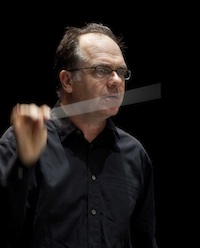 In this column, our goal is to stimulate interest among families and children in Classical Music, but as we sift through calendars and press releases we often wonder whether a certain performance is too sophisticated for kids. Will they be bored? Will they feel overwhelmed? What is age-appropriate?
In this column, our goal is to stimulate interest among families and children in Classical Music, but as we sift through calendars and press releases we often wonder whether a certain performance is too sophisticated for kids. Will they be bored? Will they feel overwhelmed? What is age-appropriate?
On the one hand, you don’t want to lose the audience of the future. On the other hand, is it such a bad thing for a child to be bored, or ambivalent, or a little overwhelmed? Does every artistic expression need to follow the new-new cultural assumption, ever defensive, that it’s better to dumb-down, that there shouldn’t be a nano-second’s relief from stimulation and instant comprehension?
Definitely not.
That said, we recommend Cal Performances' Ojai North, which presents the first Bay Area performance of John Luther Adams’ Inuksuit; by all accounts, alluring, rich, and strange. Great is the word you often hear to describe this work for nine to 99 percussion and piccolo players. The concert is on June 11 and will feature 21 players at Faculty Glade outside of Hertz Hall on the UC Berkeley campus. The concert is free.
One reviewer of the piece noted that it was impossible to critique because the musicians are spread out in three groups in an outdoor setting, and there is no single focal point. The reviewer went on to note an interesting reaction to the piece: Afterwards, people under 30 started making out.
Please don’t consider that a warning, but it is often the assumption that only older people will understand or be affected by an unconventional piece of music, which is nonsense.
Inuksuit grew out of time Adams spent in Alaska working as an environmentalist. His good friend and the conductor of the piece, as well as a player, is Steven Schick, distinguished professor of music at the University of California, San Diego and a consulting artist in percussion at the Manhattan School of Music. He’s also the author of several books including The Percussionist's Art: Same Bed, Different Dreams.
“I know John very well,” says Schick, “and over the years we have had ongoing conversations about whether it’s possible to effectively perform a percussion piece outdoors. This piece is a result of those conversations and has been played in a desert, in a forest, and in the tundra.
“The piece starts with 21 players in a circle and gradually they disperse. One third go to an outer ring. They play nontraditional percussion. I’m in that part. We begin with breathing and playing a conch shell and there are sirens. Meanwhile, two other groups disperse to play drums.
“As you listen sometimes the effect is like passing cloud shapes. And that it’s primary interest to me, as a kind of poetry … It takes a different kind of listening but in fact the piece tells you how it wants to be heard. I’ve always felt that a good piece of music should change the way you feel about the world. This does that, I think, certainly for me.”
Best Bets For Kids, This Weekend
Summer Sunsets Steel Drum Concert
Bay Area Discovery Museum, Saturday, June 9: Fantastic museum for kids in Sausalito hosts evening concert. At 5:30, Clifford the Dog will greet children; at 6:30, Mark Rosenthal and his band play tunes — reggae and calypso from Trinidad, as well as jazz and pop tunes. Summer Sunsets Concert With Mark Rosenthal.Peninsula Girls Chorus, Spring Concert
Woodside High School, Burlingame, Saturday, June 9: 240 girls can't be wrong. If your girl might be interested in singing with a chorus, take her to see this one. Features a range of chorus levels, including the most advanced ensemble of high school age girls. Lots of great music, including some new compositions. Peninsula Girls Chorus: Come to the Music.San Francisco Girls Chorus
S.F. Conservatory of Music, Friday and Saturday, June 8-9. One of the top girls choruses in the world; their spring concert includes Christopher O'Riley's arrangements of Joni Mitchell songs, plus Eric Whitacre's popular Five Hebrew Love Songs and more. S.F. Girls Chorus: Truth and Beauty.Golden Gate Park Band Festival
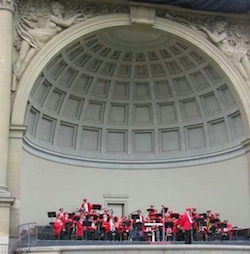 On the concourse between 9th Ave. and Lincoln, 11 a.m. to 5 p.m. Free concert in Golden Gate Park featuring 11 bands from around Northern California playing music ranging from classic band pieces to contemporary and arrangements. Take in some music, use the park — what's not to love? Golden Gate Park Band Festival.
On the concourse between 9th Ave. and Lincoln, 11 a.m. to 5 p.m. Free concert in Golden Gate Park featuring 11 bands from around Northern California playing music ranging from classic band pieces to contemporary and arrangements. Take in some music, use the park — what's not to love? Golden Gate Park Band Festival.
